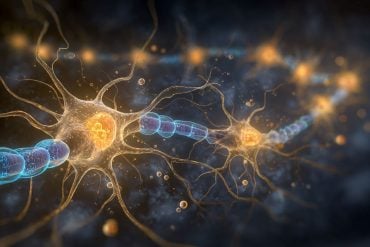Summary: Scientists have discovered that a toxic complex formed between NMDA receptors and TRPM4 channels drives neuron death in Alzheimer’s disease. Using a novel molecule called FP802, researchers were able to break apart this “death complex” in mice, preventing cognitive decline, synapse loss, and mitochondrial damage.
The treatment also reduced amyloid buildup, suggesting it could offer broader protection than existing therapies. While still in early stages, the findings open a promising new path for treating Alzheimer’s and other neurodegenerative diseases like ALS.
Key Facts
- Toxic Complex Identified: The NMDAR/TRPM4 complex causes neuronal death and fuels Alzheimer’s progression.
- Drug Candidate: FP802 disrupted the complex in mice, preserving memory, synapses, and mitochondrial health.
- Novel Approach: Targets downstream cell death mechanisms instead of directly removing amyloid plaques.
Source: Heidelberg University
A molecular mechanism that significantly contributes to the progression of Alzheimer’s disease has been discovered by a research team led by neurobiologist Prof. Dr Hilmar Bading of Heidelberg University.
In joint experiments with researchers from Shandong University (China), the team, using an Alzheimer’s mouse model, demonstrated that a neurotoxic protein-protein complex is responsible for nerve cells in the brain dying off and the resulting cognitive decline.

According to the scientists, this finding opens up new perspectives for the development of effective treatments.
The protein-protein complex, known from previous studies, consists of the NMDA receptor and the TRPM4 ion channel. NMDA receptors, which take part in signal transmission between nerve cells, are found on the surface of the cells and are present both in the synapses and outside these contact points between nerve cells.
They are activated by a biochemical messenger, the neurotransmitter glutamate. While the activation of synaptic NMDA receptors in the brain is critical for the survival of nerve cells as well as the preservation of cognitive abilities, TRPM4 gives the extrasynaptic NMDA receptors toxic properties.
Together they build a “death complex” that can lead to damage as well as the death of nerve cells, explains Hilmar Bading, who directs the Institute of Neurobiology at Heidelberg University’s Interdisciplinary Center for Neurosciences (IZN).
The neurotoxic NMDAR/TRPM4 complex is present at much higher levels in Alzheimer’s mice than in healthy animals, the research shows.
Using the novel pharmaceutical compound FP802, a so-called “TwinF Interface Inhibitor” discovered in previous studies by Prof. Bading and his team at the IZN, the international research team demonstrated that the NMDAR/TRPM4 complex plays a key role in the progression of cognitive decline.
In experiments on a mouse model, they succeeded in breaking the deadly protein-protein complex apart using this neuroprotective molecule. FP802 binds to the so-called “TwinF” contact surface through which TRPM4 interacts with NMDA receptors, thereby blocking the physical interaction between the two proteins and dissolving the complex.
“In Alzheimer’s mice treated with the molecule, disease progression was markedly slowed,” states Dr Jing Yan, a researcher in Prof. Bading’s team who now works at FundaMental Pharma, a biotech offshoot of the IZN’s Institute of Neurobiology.
Typical cellular changes due to Alzheimer’s disease – including the loss of synapses and structural and functional damage to mitochondria, the powerhouses of the cell – developed only to a limited extent or not at all, the scientists report.
Cognitive abilities such as learning and memory remained largely preserved. In addition, the characteristic formation of beta-amyloid deposits in the brain was significantly reduced.
According to Prof. Bading, this approach fundamentally differs from previous treatment strategies for Alzheimer’s disease.
“Instead of targeting the formation or removal of amyloid from the brain, we are blocking a downstream cellular mechanism, the NMDAR/TRPM4 complex, that can cause the death of nerve cells and – in a disease-promoting feedback loop – promotes the formation of amyloid deposits,” states the Heidelberg neurobiologist.
In prior studies, the team was able to demonstrate comparable neuroprotective effects of the TwinF Interface Inhibitor FP802 in disease models for amyotrophic lateral sclerosis (ALS), in which the NMDAR/TRPM4 complex also plays a role.
The researchers therefore believe they have found in the novel inhibitor a potentially widely applicable pharmacological principle that could slow or even stop the progression of neurodegenerative diseases like Alzheimer’s and ALS. Prof. Bading reports, however, that a prospective clinical application is still a long way off.
“The previous results are quite promising in the preclinical context, but comprehensive pharmacological development, toxicological experiments, and clinical studies are needed to realize a possible application in humans,” stresses the scientist.
In close cooperation with FundaMental Pharma, the neuroprotective molecule FP802 is to be optimized for this in the coming years.
Funding: The research was funded by the German Research Foundation, the European Research Council, the former Federal Ministry of Education and Research, the National Natural Science Foundation of China, and the east Chinese province of Shandong.
The results were published in the journal Molecular Psychiatry.
About this genetics and Alzheimer’s disease research news
Author: Ute Mueller-Detert
Source: Heidelberg University
Contact: Ute Mueller-Detert – Heidelberg University
Image: The image is credited to Neuroscience News
Original Research: Open access.
“The NMDAR/TRPM4 death complex is a major promoter of disease progression in the 5xFAD mouse model of Alzheimer’s disease” by Hilmar Bading et al. Molecular Psychiatry
Abstract
The NMDAR/TRPM4 death complex is a major promoter of disease progression in the 5xFAD mouse model of Alzheimer’s disease
Alzheimer’s disease (AD) is the most prevalent neurodegenerative disorder, characterized by cognitive decline and neuronal degeneration.
The formation of amyloid β plaques and neurofibrillary tangles are key morphological features of AD pathology. However, the specific molecules responsible for the cell destruction triggered by amyloid β and tau proteinopathies in AD has not yet been identified.
Here we use the 5xFAD mouse model of AD to investigate the role of a recently discovered death signaling complex which consists of the extrasynaptic N-methyl-D-aspartate receptor (NMDAR) and the transient receptor potential cation channel subfamily M member 4 (TRPM4).
The NMDAR/TRPM4 death complex is responsible for toxic signaling of glutamate, which has been implicated in AD pathogenesis.
We detected an increase in NMDAR/TRPM4 death complex formation in the brains of 5xFAD mice. This increase was blocked by the oral application of FP802, a small molecule TwinF interface inhibitor that can disrupt and thereby detoxify the NMDAR/TRPM4 death complex.
FP802 treatment prevented the cognitive decline of 5xFAD mice assessed using a series of memory tasks. It also preserved the structural complexity of dendrites, prevented the loss of synapses, reduced amyloid β plaque formation, and protected against pathological alterations of mitochondria.
These results identify the NMDAR/TRPM4 death complex as a major promoter of AD disease progression, amplifying potentially self-perpetuating pathological processes initiated by amyloid β.
TwinF interface inhibitors offer a novel therapeutic avenue, serving as an alternative or complementary treatment to antibody-mediated clearing of amyloid β from AD brains.






